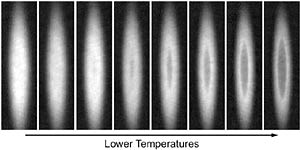
Light Shed on Superfluidity
For the first time, scientists have directly observed the transition of a gas to a superfluid, a form of matter closely related to the superconductors that allow electrical currents to travel without resistance. Such observations may help solve lingering questions about high-temperature superconductivity, which has widespread applications for magnets, sensors and energy-efficient transport of electricity.
The superfluid gas created by researchers at the Massachusetts Institute of Technology can also serve as an easily controlled model system to study properties of neutron stars or the quark-gluon plasma that existed in the early universe, they said. The work, reported in the July 6 issue of Nature and in the July 18 issue of Physical Review Letters, was led by Nobel laureate Wolfgang Ketterle, the John D. MacArthur Professor of Physics and a principal investigator in MIT's Research Laboratory of Electronics.
Direct observation of the superfluid phase transition in ultracold Fermi gases. The images show the excess atoms in the gas cloud that are not involved in the superfluid pairing. As the superfluid forms in the center, the excess atoms have to give way and start forming a shell around it. (Image: Martin Zwierlein)
The team observed the transition to superfluidity of a gas of so-called fermionic atoms. Fermionic atoms are atoms with an odd number of neutrons, protons and electrons. They can become superfluid only if they form pairs. These pairs then have an even number of basic constituents and can form a kind of Bose-Einstein condensate, a type of matter where all pairs act as a giant matter wave, "march in lockstep" and flow without friction.
For several years, research groups around the world have seen the transition of a Fermi gas to superfluidity only indirectly because this transition was not accompanied by any change in the appearance of the gas cloud.
The new trick used by the MIT group was to have an unequal number of two kinds of fermions, sometimes labeled as spin up and spin down. In this situation, not all the atoms can find a partner to form a pair, and the difference between the paired superfluid and the gas of unpaired atoms is clearly visible.
Imagine the two kinds of fermions as women and men on the dance floor who have to pair up to perform a superfluid dance. At first, it was not clear what would happen if the men outnumbered the women. Would the single men take part in the dance, would they stay at the side of the dance floor or would their presence cause everyone to stop dancing? The dance ends when the ratio of men to women exceeds six to one -- this breakdown of superfluidity was observed by the MIT researchers in 2005. For a smaller ratio, the superfluid dance continues.
In the current work, the MIT team has found that for the superfluid dance to go on, the single men (excess atoms) must be expelled from the dance floor. This expulsion is directly observed as the shell of excess atoms surrounding the superfluid core. When the atoms are cooled down, the appearance of superfluidity is accompanied by a sudden change in the shape of the cloud.
"To see directly how the superfluid core forms in the center is quite amazing," said physics graduate student Martin Zwierlein. Postdoctoral associate Yong-Il Shin said, "Our results challenge state-of-the-art theory. The features we have observed are very difficult to reproduce in calculations."
Ketterle's team members, in addition to Zwierlein and Shin, were MIT physics graduate students André Schirotzek and Christian Schunck. All are members of MIT's Center for Ultracold Atoms. The team observed fermionic superfluidity by cooling the gas close to about 50 billionths of 1 kelvin, very close to absolute zero (-273 °C or -459 °F). By using phase-contrast imaging -- a standard microscopy technique -- in a novel way, they could directly observe the superfluid core and the shell of excess atoms around it.
Properties of superfluid ultracold fermions are also being studied by teams at the University of Colorado at Boulder, the University of Innsbruck in Austria, the École Normale Supérieure in Paris, Duke University and Rice University. The Rice group has also studied imbalanced Fermi mixtures.
The MIT research was supported by the National Science Foundation, the Office of Naval Research and NASA. For more information, visit: www.mit.edu
CAPTION:
/Buyers_Guide/American_Air_Water_Inc/c657